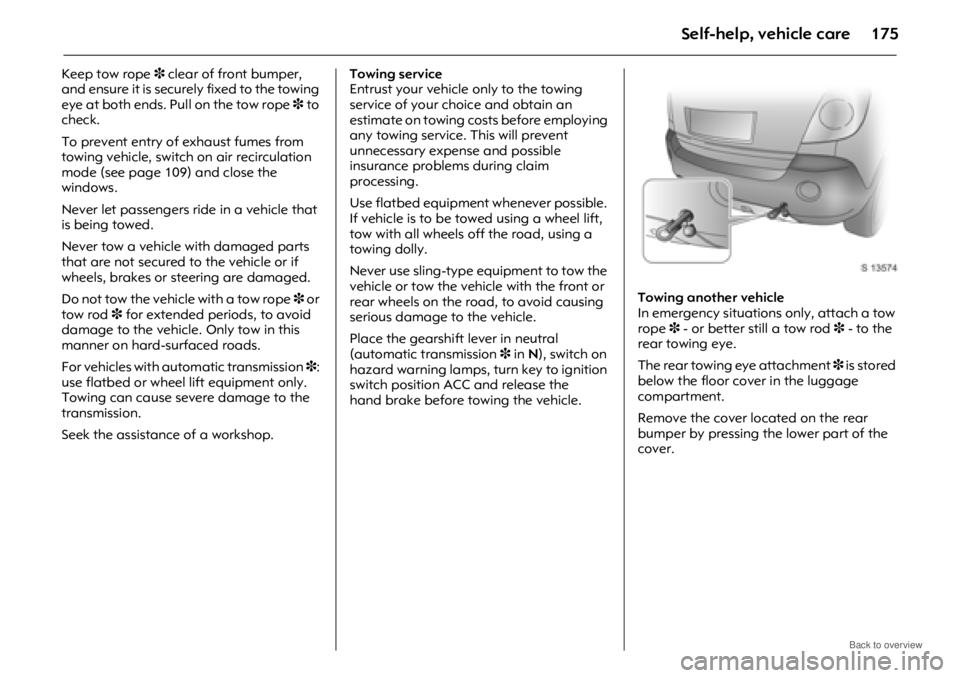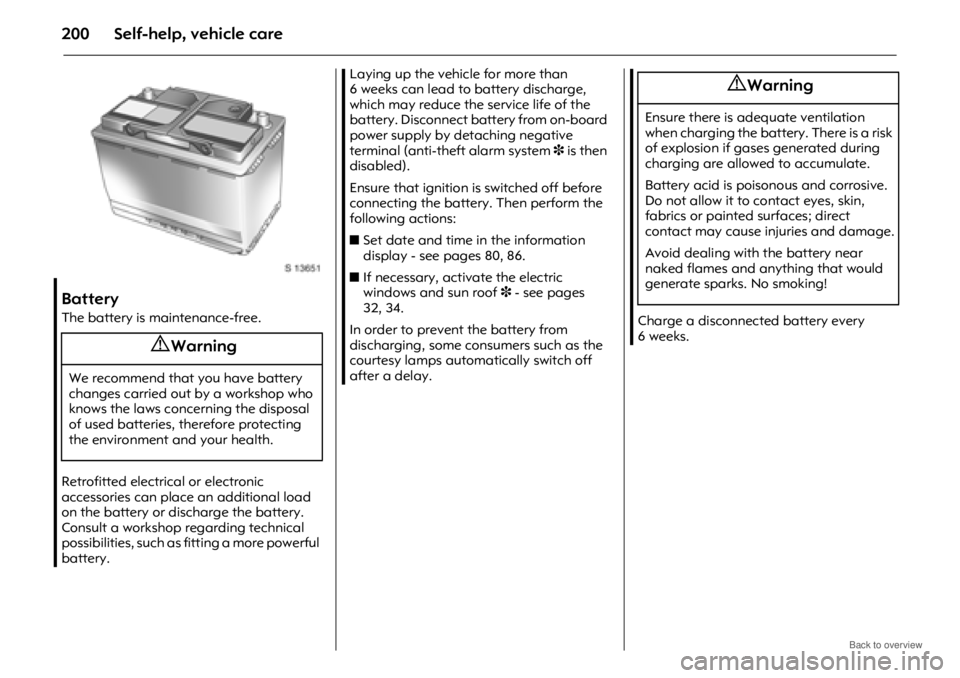service OPEL ANTARA 2009 Owners Manual
[x] Cancel search | Manufacturer: OPEL, Model Year: 2009, Model line: ANTARA, Model: OPEL ANTARA 2009Pages: 234, PDF Size: 3.01 MB
Page 3 of 234

3
Your Antara
is an intelligent combination of forward-
looking technology, impressive safety,
environmental friendliness and economy.
It now lies with you to drive your vehicle
safely and ensure that it performs
perfectly. This Owner's Manual provides
you with all the necessary information to
that end.
Make sure your passengers are aware of
the possible risk of accident and injury
which may result from improper use of the
vehicle.
You must always comply with the specific
laws of the country that you are travelling
through. These laws may differ from the
information in this Owner’s Manual.
When instructed to consult a workshop,
we recommend that you consult an
Opel Partner.
All Opel Partners offer first-class service at
reasonable prices.
You will receive quick, reliable and
individual service.
Experienced mechanics, trained by Opel,
work according to specific Opel
instructions.
The Owner's Manual should always be kept
together with the Service and Warranty
Booklet in the vehicle: Ready to hand in the
glove compartment.
Make use of the Owner's Manual:
z Its "In brief" section will give you an initial
overview.
z The table of contents at the beginning of
the Owner’s Manual and within the
individual chapters will show you where
everything is.
z Its index will help you find what you
want.
z It will familiarise you with the
sophisticated technology.
z It will increase your pleasure in your
vehicle.
z It will help you to handle your vehicle
expertly.
The Owner’s Manual is designed to be
clearly laid-out and easily understood. This symbol signifies:
6
Continue reading on next page.
3 The asterisk signifies equipment not
fitted to all vehicl es (model variants,
engine options, mode ls specific to one
country, optional equipment, Opel
genuine parts and accessories).
Yellow arrows in the illustrations serve as
points of reference or indicate some action
to be performed.
Black arrows in the illustrations indicate a
reaction or a second action to be
performed.
Directional data, e.g. left or right, or front
or back, in the descriptions always relates
to the direction of travel.
We wish you many hours of pleasurable
driving
Your Opel Team
9 Warning
Text marked 9 Warning provides
information on risk of accident or injury.
Disregard of the instructions may lead to
injuries or endanger life.
Inform your passengers accordingly.
Page 5 of 234

5
ContentsHandling characteristics
All Wheel Drive vehicles have a high centre
of gravity due to the increased ground
clearance required for off-road use.
A s w i t h o t h e r v e h i c l e s o f t h i s t y p e , f a i l u r e t o
operate the vehicle correctly may result in
loss of control or an accident.
Please read the sections "All Wheel Drive"
on page 121 and "Driving hints" on
page 127.In brief .........................................................6
Locks, doors, windows ............................ 21
Seats, interior ........................................... 36
Instruments, cont
rols ............................... 70
Lighting .................................................... 94
Infotainment system .............................. 101
Climate control ...................................... 103
Driving and operation .......................... 115
Self-help, vehicle care ........................... 171
Service, maintenance ............................ 206
Technical data ...................................... 215
Index ....................................................... 228
Page 124 of 234

Driving and operation124
The ground clearance, ramp angle, angle
of approach and departure and wading
depth need to be considered, especially in
hilly conditions and when wading, to
prevent the vehicle becoming stuck and
possibly damaged.
Technical data - see page 215. Driving through water
Do not exceed th
e maximum wading
depth.
Check the depth of water: choose the
lowest entry and departure angles before
entering.
Maintain a steady engine speed, to help
prevent water from entering the exhaust
system, but do not exceed 5 km/h (3 mph),
to avoid splashing the water.
Drive with the flow wherever possible, not
against it. If you have to drive against the
flow, try to drive at an angle to it, so that
the leading corner of the vehicle will help
deflect water from the engine
compartment.
Avoid splashing the water - if the ignition
system becomes wet, the engine may stall. Avoid water entering the air intake system.
Test the brakes after leaving the water -
wet brakes are less effective than dry ones.
Perform the service operations for wading,
involving checks for water contamination,
at the earliest opportunity.
Service checks after wading -
see page 126.
9 Warning
If water enters the air intake system,
engine seizure with severe costly damage
may result.
Page 126 of 234

Driving and operation126
Maintenance
Certain maintenance operations, e.g.
changes of engine oil, oil filter, air cleaner
element and brake pads, are required
more frequently for severe operating
conditions, e.g. driving on unsurfaced
roads, during thick dust or mud
accumulation, etc.
If the vehicle is driven off-road to a great
extent, the chassis will need regular
inspection.
Your Opel Partner will inform you which
additional service is required between the
normal service intervals, after
consideration of the specific operating
conditions of your vehicle.
Further information - see page 206.
Service checks after wading
After wading, check for the ingress of water
into the following:
zBrake fluid reservoir,
z Air cleaner element,
z Engine,
z Transmission,
z Axles,
z Interior of vehicle.
Renew any lubricating oil or hydraulic fluid
that has a milky appearance, indicating
contamination with water. All Wheel Drive summary
Do
z
Check fuel and tyres, water and oil levels
before venturing off-road.
z Survey on foot before driving off-road,
especially when traversing hillsides,
wading, driving in deep snow and over
ridges.
z Select the correct gear for the conditions.
z Use the engine’s power of acceleration
and deceleration with the correct gear,
to control the vehicle.
z Keep a firm grip on the outer rim of the
steering wheel - keep your thumbs away
from the spokes.
z Drive carefully and be prepared for
emergencies.
z Drive slower under crosswind conditions.
z Approach obstacles and conditions
off-road at the correct angles and with
sufficient momentum to negotiate the
obstacle, but do not put undue strain on
the vehicle.
z Use caution - if you are not sure, do not
do it. Don’tz
Do not venture off-road unless you are
certain that the conditions are capable
of being negotiated safely by you and
your vehicle.
z Do not take unnecessary risks.
z Do not use the brakes excessively, to
maintain steering control.
z Do not change gear on difficult terrain -
depressing the clutch may cause the
vehicle to stop because of drag on the
wheels - or accelerate backwards or
forwards when on a hill.
z Do not ride or slip the clutch.
z Do not spin the wheels if stuck in mud,
sand or snow - they will only dig in
deeper.
z Do not drive at an excessive speed,
especially into corners. Your All Wheel
Drive vehicle has a higher centre of
gravity than conventional vehicles.
Sudden changes of direction can lead to
loss of control.
Page 135 of 234

Driving and operation135
Exhaust gases
Do not run engine in enclosed spaces, e.g.
in a garage, or sit in a parked vehicle for an
extended period with the engine running.
Do not drive with tailgate open. If driving
with the tailgate open is necessary, set fan
to highest speed, close windows and
ensure air recirculation mode is off, to allow
entry of outside air.
If the underbody or rear of vehicle is
damaged or corroded, you notice a
change in the sound of the exhaust system,
or whenever you suspect exhaust gases are
penetrating the vehicle interior, consult a
workshop immediately.
When the vehicle is driven for the first time,
wax and oil on the exhaust system may
evaporate, producing smoke-like emissions
which should not be inhaled. Allow wax
and oil to evaporate while the vehicle is in
the open air. Diesel particle filter (DPF) 3
The diesel particle filter removes polluting
soot particles out of the exhaust.
The system contains a self-cleaning
function at certain intervals. The filter is
cleaned by burning the soot particles at
high temperature. This procedure runs
automatically under certain vehicle
conditions and can take up to 15 minutes,
during which time fuel consumption may
increase. The smell and the noise that
occur are normal.
The system cannot automatically clean
itself under certain vehicle conditions, such
as driving short distances.
If control indicator
I illuminates, you
should continue driving, and as soon as the
road and traffic situation permits it,
increase speed to more than 50 km/h
(30 mph) and diesel particle filter cleaning
will start.
Cleaning is quicker at faster speeds and
under load. The engine speed should not
drop below 2000 rpm. The control indicator
extinguishes as soon as cleaning is
complete.
We recommend that you do not turn the
ignition off during cleaning. Maintenance
Have all maintenance work carried out at
the intervals specified by Opel. We
recommend that you entrust this work to
your Opel Partner, who has proper
equipment and trained personnel
available. Electronic testing of systems
permits rapid diagnosis and remedy of
faults. This way, you can be certain that all
components of the vehicle’s electrical,
injection and ignition systems operate
correctly, that your ve
hicle has a low level
of pollutant emission and that the catalytic
converter system will have a long service
life.
You are thereby making an important
contribution towards keeping the air clean
and compliance with emissions legislation.
Checking and adjustment of the fuel-
injection and ignition systems is part of the
scope of a Service. For this reason, you
should have all maintenance work carried
out at the intervals specified in the chapter
"Service, Maintanance" on page 206.
9 Warning
Engine exhaust gases contain poisonous
carbon monoxide, which has no colour or
odour and can be lethal if inhaled.
If exhaust fumes penetrate the vehicle
interior, open the windows and consult a
workshop immediately.
Page 175 of 234

Self-help, vehicle care175
Keep tow rope 3 clear of front bumper,
and ensure it is secure ly fixed to the towing
eye at both ends. Pull on the tow rope 3 to
check.
To prevent entry of exhaust fumes from
towing vehicle, switch on air recirculation
mode (see page 109) and close the
windows.
Never let passengers ride in a vehicle that
is being towed.
Never tow a vehicle with damaged parts
that are not secured to the vehicle or if
wheels, brakes or steering are damaged.
Do not tow the vehicle with a tow rope 3 or
tow rod 3 for extended periods, to avoid
damage to the vehicle. Only tow in this
manner on hard-surfaced roads.
For vehicles with automatic transmission 3:
use flatbed or wheel lift equipment only.
Towing can cause severe damage to the
transmission.
Seek the assistance of a workshop. Towing service
Entrust your vehicle only to the towing
service of your choice and obtain an
estimate on towing costs before employing
any towing service. This will prevent
unnecessary expense and possible
insurance problems during claim
processing.
Use flatbed equipment whenever possible.
If vehicle is to be towed using a wheel lift,
tow with all wheels off the road, using a
towing dolly.
Never use sling-type equipment to tow the
vehicle or tow the vehicle with the front or
rear wheels on the road, to avoid causing
serious damage to the vehicle.
Place the gearshift lever in neutral
(automatic transmission 3
in N), switch on
hazard warning lamps, turn key to ignition
switch position ACC and release the
hand brake before towing the vehicle. Towing another vehicle
In emergency situations only, attach a tow
rope
3 - or better still a tow rod 3 - to the
rear towing eye.
The rear towing eye attachment 3 is stored
below the floor cover in the luggage
compartment.
Remove the cover located on the rear
bumper by pressing the lower part of the
cover.
Page 200 of 234

Self-help, vehicle care200
Battery
The battery is maintenance-free.
Retrofitted electrical or electronic
accessories can place an additional load
on the battery or discharge the battery.
Consult a workshop regarding technical
possibilities, such as fitting a more powerful
battery.Laying up the vehicle for more than
6 weeks can lead to battery discharge,
which may reduce the service life of the
battery. Disconnect battery from on-board
power supply by detaching negative
terminal (anti-theft alarm system
3 is then
disabled).
Ensure that ignition is switched off before
connecting the battery. Then perform the
following actions:
z Set date and time in the information
display - see pages 80, 86.
z If necessary, activate the electric
windows and sun roof 3 - see pages
32, 34.
In order to prevent the battery from
discharging, some consumers such as the
courtesy lamps automatically switch off
after a delay. Charge a disconnected battery every
6 weeks.
9 Warning
We recommend that you have battery
changes carried out by a workshop who
knows the laws concerning the disposal
of used batteries, therefore protecting
the environment and your health.
9 Warning
Ensure there is adequate ventilation
when charging the batt
ery. There is a risk
of explosion if gases generated during
charging are allowed to accumulate.
Battery acid is poisonous and corrosive.
Do not allow it to contact eyes, skin,
fabrics or painted surfaces; direct
contact may cause injuries and damage.
Avoid dealing with the battery near
naked flames and anything that would
generate sparks. No smoking!
Page 206 of 234

Service, maintenance206
Service, maintenanceEuropean service intervals
Engine oil change - Z 24 XE only
Due every 15,000 km (10,000 miles).
Main Service
Due every 30,000 km (20,000 miles) or
1 year, whichever occurs first.
International service intervals
Interim Service - except Z 24 XE
Due every 15,000 km (10,000 miles).
Main Service - except Z 24 XE
Due every 30,000 km (20,000 miles) or
1 year, whichever occurs first.
Interim Service - Z 24 XE only
Due every 10,000 km (6,500 miles) or
6 months, whichever occurs first.
Main Service - Z 24 XE only
Due every 20,000 km (13,000 miles) or
1 year, whichever occurs first.
Confirmations
Confirmation of Service is recorded in the
spaces provided in the Service and
Warranty Booklet. The date and kilometre/
mileage reading is completed with the
stamp and signature of the Servicing
Workshop.
Make sure that the Service and Warranty
Booklet is completed correctly as
continuous proof of service is essential if
any warranty or goodwill claims are to be
met, and is also a benefit when you come
to sell the vehicle.
Service plan
The European service schedule is valid for
the following countries:
Andorra, Austria, Belgium, Cyprus,
Czech Republic, Denmark, Estonia,
Finland, France, Germany, Greece,
Greenland, Hungary, Iceland, Ireland, Italy,
Latvia, Lithuania, Luxembourg, Malta,
The Netherlands, Norway, Poland,
Portugal, Slovakia, Slovenia, Spain,
Sweden, Switzerland, United Kingdom.
For all remaining countries the
International service schedule applies.
European service schedule ................ 207
International service schedule ........... 209
Additional servicing............................ 213
Recommended fluids and lubricants 213
Page 207 of 234

Service, maintenance 207
European service schedule
(Antara Z 20 DM, Z 20 DMH, Z 24 XE, Z 32 SE) Service operations by year 1)
km ( x 1000)1)
miles ( x 1000)1)
1)Whichever occurs first.
15
101
30
20 45
30 2
60
40 75
50 3
90
60
Controls, lighting, signalling equi pment and airbags: visual check
steering lock and ignition lock: check xxx
Remote control batteries: replace Every 2 years
Windscreen wipers, windscreen washer system: check, correct xxx
Coolant level and antifreeze: check, correct
Hoses: check for tightness and secure seating xxx
Brake fluid level: check, correct xxx
Battery terminals: check for secu re connections and battery eye xxx
Vehicle system check with TECH2 xxx
Pollen filter: replace xxx
oMore often for when dust, sand or polle n is in the air Agreement with customer
Air cleaner element: replace
xxx
⊕Spark plugs and plug leads: replace Every 90 000 km/60 000 miles
Ribbed V-belt: visual check xxx
⊕Toothed belt and tension roller: visual check xxx
Toothed belt and tension roller: replace - Z 24 XE Every 8 years/120 000 km/80 000 miles
Toothed belt and tension roller: replace - Z 20 DM, Z 20 DMH Every 6 years/90 000 km/60 000 miles
Power steering system: check for leak s. Fluid level: check, correct xxx
Engine oil and oil filter: replace - fixed interval Z 24 XE
2)
2)On vehicles with oil life monitoring, it may be necessary to change the engine oil earlier (control indicator illuminates).
xxxxxx
Z 20 DM, Z 20 DMH, Z 32 SE, except2)xxx
Page 208 of 234

208 Service, maintenance
Service operations by year 1)
km ( x 1000)1)
miles ( x 1000)1)
1)Whichever occurs first.
⊕ Additional operations.
o Under extreme operating conditions and if required by country-specific conditions, the intervals are reduced.
15
10 1
30
20 45
30 2
60
40 75
50 3
90
60
⊕o Diesel fuel filter: drain water
(If relative humidity is high an
d/or fuel is of lower quality) Annually
Fuel filter: replace and drain water - diesel (g rade EN 590) Every 2 years/60 000 km/40 000 miles
Parking brake: check and adjust
Wheel mounting and suspension front an d rear, brake lines, brake pressure
hoses, fuel lines and exhaust system: visual check xxx
Corrosion protection: check and record in Service and Warranty Booklet Annually
Front and rear wheel br akes: check visually xxx
o
⊕Annual service check if annual mileage exceeds 20 000 km Annually
Engine, transmission, PTO, rear differential, A/C compressor: check for leaks xxx
Steering system boots, track rods , final drive: visual check xxx
Track rod end and supporting ball joint: check xxx
⊕Brake and clutch fluid: change Every 2 years
Wheel fastening: loosen and tighten to torque
Tyre condition and pressures: check, correct xxx
⊕Annual service check if annual
mileage exceeds 20 000 km Annually
First aid kit, tyre repair kit and lash ing eyes: visual check Every 2 years
Headlamp aiming: check, adjust x x x
Door hinges, door stop, lock cylinder, lock striker, bonnet catch, tailgate
hinges and check links: lubricate xxx
Test drive, final check
Service interval display and oil life monitor: reset - if applicable xxx